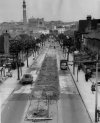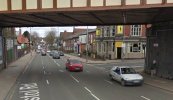-
Welcome to this forum . We are a worldwide group with a common interest in Birmingham and its history. While here, please follow a few simple rules. We ask that you respect other members, thank those who have helped you and please keep your contributions on-topic with the thread.
We do hope you enjoy your visit. BHF Admin Team
You are using an out of date browser. It may not display this or other websites correctly.
You should upgrade or use an alternative browser.
You should upgrade or use an alternative browser.
removal of tram lines selly oak
- Thread starter Astoness
- Start date
Richard Dye
master brummie
I don’t know the area but I wondered where they took that photo from, is that a dead end?
I don’t know the area but I wondered where they took that photo from, is that a dead end?
looks like the clock tower of the university of birmingham so maybe taken near or on the bristol road but not certain
lyn
Dave Riley
master brummie
Richard Dye
master brummie
Oop’s I should know that as I went there for 2 years!looks like the clock tower of the university of birmingham so maybe taken near or on the bristol road but not certain
lyn
Radiorails
master brummie
Birmingham being progressive? I suppose the local council thought so at the time. The city had a fine tram system and the makings of one which has been discontinued. As with many of the industries that have been lost the city started to look inward, I feel, after WW2.
Richard Dye
master brummie
I think that to many wrong decisions were made by wrong people (sorry off topic, not intending to be political).Birmingham being progressive? I suppose the local council thought so at the time. The city had a fine tram system and the makings of one which has been discontinued. As with many of the industries that have been lost the city started to look inward, I feel, after WW2.
Lloyd
master brummie
At the time, the tram network was outdated and suffering from lack of care due to the war. Much of the infrastructure (wiring, both overhead and feeders) needed replacing as did the fleet. The corporation no longer made its own electricity after nationalisation, and had to pay commercial rates for it. Diesel fuel was cheap, and buses much cheaper than new trams. Abandonment had been planned for the 1940s, but was delayed by the war (fueland vehicle shortages). Sadly it was the right decision to replace them when they did.I think that to many wrong decisions were made by wrong people (sorry off topic, not intending to be political).
Radiorails
master brummie
But parts of Europe, which suffered the most in WW2, set about with the repair of their country which included buildings and passenger transport Lloyd. But I guess we were in hock far paying for the liberation of Europe.
Lloyd
master brummie
Exactly. We paid for the restoration of many German & other European cities after the war, leaving little cash for our own reconstruction.But parts of Europe, which suffered the most in WW2, set about with the repair of their country which included buildings and passenger transport Lloyd. But I guess we were in hock far paying for the liberation of Europe.
I can imagine that our narrow gauge trams themselves were a problem in terms of capacity and efficiency. You can get a bus to carry the same about of people, if not more without expensive the infrastructure maintenance of rails and overhead lines.
They were a thing of their time compared with he modern standard gauge trams with a vastly superior carrying capacity.
They were a thing of their time compared with he modern standard gauge trams with a vastly superior carrying capacity.


